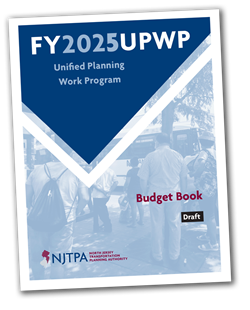 The NJTPA Board of Trustees approved a work program for the next fiscal year, which includes updating the Long Range Transportation Plan (LRTP), and launching three new pilot programs.
The NJTPA Board of Trustees approved a work program for the next fiscal year, which includes updating the Long Range Transportation Plan (LRTP), and launching three new pilot programs.
The Fiscal Year 2025 Unified Planning Work Program, which begins July 1, details the work of NJTPA’s Central Staff, its member agencies and the state’s eight transportation management associations.
The LRTP is one of the agency’s core documents. It sets a vision for the region’s transportation future and guides the NJTPA’s work. The Board is set to adopt the plan in September 2025. In tandem with this, Central Staff will also work to update the Transportation Improvement Program, or TIP, which is a four-year list of federally funded projects included in the LRTP. Staff will also lead a consultant effort to estimate the emissions impact of these projects, to ensure they do not have a negative impact on the region’s air quality. This is called the Air Quality Conformity Determination. This determination and the TIP will also go to the Board for consideration in September 2025.
The work program includes several new pilot programs:
- Complete Streets Conceptualization: This effort will provide consultant-supported planning and project development assistance to advance a local Complete Streets project that addresses community and regional goals regarding safety, accessibility, equitable access to employment and other destinations, access to public transportation, and reduction of single-occupancy vehicle trips. This study will also develop guidelines for a Complete Streets Conceptualization Program including project identification, prioritization and selection, the specific steps to complete the process, and final deliverables.
- Pedestrian Lighting Analysis: This effort will examine up to 26 locations across the NJTPA region. While only 25 percent of vehicle miles travelled occur at night, the nighttime pedestrian fatality rate is three times higher than during the day. Recommendations will be developed to improve lighting and pedestrian safety at each location. The reports prepared for each location can be used to advance projects through the NJTPA’s Local Safety Program.
- Intersection Control Evaluation: This effort was recommended in New Jersey’s last Strategic Highway Safety Plan update. It will help develop a performance-based approach for screening alternatives and identifying optimal geometric and traffic control solutions for high-crash intersections. Staff will work with the NJTPA subregions to select 15 locations for evaluation.
The work program also includes two Freight Concept Development studies, Southern Middlesex County North-South Truck Corridor Project in Cranbury and Monroe, Middlesex County; and Hanover Avenue Bridge Catenary Rail Clearance Project in Morris Plains, Morris County.
Several initiatives that began in FY 2024 will conclude in the next fiscal year, including the completion of Local Safety Action Plans for eight counties in the NJTPA region; a consultant-led effort to gather public input for the LRTP; demographics and travel analysis, and freight industry forecasts, which will be used for the LRTP update.